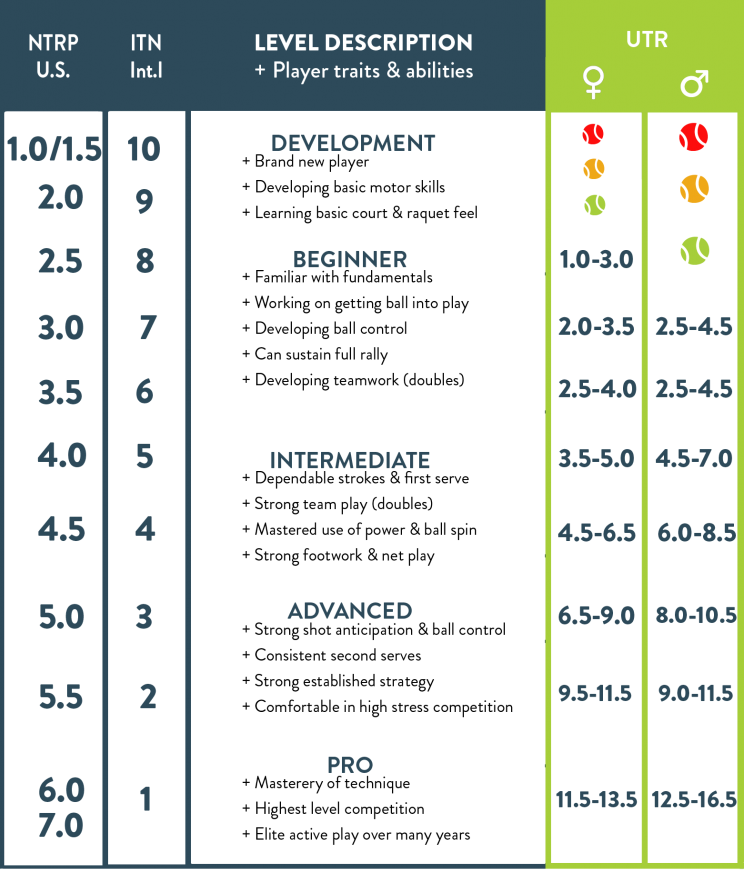Tennis Levels: Beginner, Intermediate & Advanced (Explained)

Any individual sport becomes so much better when two players are facing up against each other with the same relative skill level. It will provide a good battle, and no one is holding the other back.
While there are different ways to differentiate skill levels, using three different tennis levels can be a pretty general way to go about it. This is a look at beginner, intermediate, and advanced tennis players. Those still trying to figure out where they fall can look at the different aspects of a player at this level.
What Are The Common Rating Systems For Tennis Players?

For more refined rating systems, players in the United States rely on two different ways to measure skill. They both work a bit better than simply saying beginner, intermediate, or advanced.
USTA NTRP Rating
The United States Tennis Association has a rating system for tennis players. It ranges from 1.5 to 7.0. A 1.5 player is a beginner with no real athletic experience in general. They are still trying to learn everything in the game, and they won’t be at that level for long.
Players at the 7.0 level are some of the best players in the world. They are competing against the best of the best, and they’re all making money playing the sport.
- 1.0 – Beginner, just started playing
- 1.5 – Player working on getting the ball into play
- 2.0 – Player knows how to use all the different strokes, but lacks experience
- 2.5 – Player is ready to play local tournaments/league games
- 3.0 – Players is fairly consistent in hitting medium-paced shots, but lacks depth and variety
- 3.5 – Player has a reliable, solid game built over years of match play, but lacks variety
- 4.0 – Similar to 3.5, but with more variety
- 4.5 – Player has a solid serve and can vary spin and pace
- 5.0 – Player has good shot anticipation & can consistently hit different strokes with depth and control
- 5.5 – Similar to 5.0, but the player has developed pace and/or consistency as a major weapon
- 6.0-7.0 – Pro player (Top 1000 ATP or WTA)
To break these levels down a bit, here’s what it means:
- 1.0 – 2.0 = Beginner
- 2.5 – 4.0 = Intermediate
- 4.5 – 5.5 = Advanced
- 6.0 – 7.0 = Professional
A lot of local leagues start to begin with players who have a 3.0 rating (some have 2.5). There are 3.0, 3.5, 4.0, and 4.5 leagues in most local areas. After that, a lot of leagues and tournaments will be “open” so that anyone can enter. That means a 5.0 could be playing against a 6.0, depending on who signs up.
Beginner
Tennis players just starting should still know the basics of the sport, and can hit the ball somewhat. There will always be some people starting completely from scratch, but most are coming over from another sport and have some level of hand-eye coordination.
Beginners shouldn’t even think about some of the finer aspects of the game. Working on volleys and groundstrokes at this stage builds fundamentals. Doing a group lesson with coaches, or even a private lesson, consists of a lot of basic work. While it might look rather mundane to the average tennis player, it is essential to have strong building blocks.
As far as going from beginner to intermediate, it takes a better well-rounded game in general. Improving the basics like the forehand, backhand, volleying, and serving will eventually get a player there.
Matches are possible at the beginner level, but it often gets frustrating for players since the rallies are short and the unforced errors are high. That’s why some coaches will recommend strictly sticking to practice at this level. Once a player becomes consistent enough that they fall into the intermediate level, that’s when they can begin to play matches.
Beginner equipment doesn’t need to be anything too crazy. Some starting will use a racquet that they can purchase at a big box department store.
Buying a brand new racquet that the pros use is often seen as a waste of money. That’s because so many beginners never fully fall in love with the game, and that means they don’t need a racquet that’s over $200. Here’s my racquet recommendations for beginners.
Intermediate
Reaching an intermediate level in tennis means that a person is actually into the sport enough to practice regularly. Even great athletes don’t automatically become intermediate players, because there’s a lot of refined skill that goes into hitting the ball consistently.
Intermediate players understand some of the basics for playing matches at a high level as well. Being able to keep score, have basic strategy down, and more all go into being a consistent intermediate player. Since intermediate levels can cover a wide array of players, those on the high end will be able to dominate against those on the lower end.
Consistency starts to show with intermediate tennis play as well. When a player is hitting consistently, they become more confident in refining the technique. Players who can begin improving their accuracy while also hitting a ball at a decent pace will start to move up the ranks depending on the leagues they are playing.
The intermediate level usually starts the process of players finding some sort of ranking so they can be more specific about where they play. A USTA player, as an example, can be a 2.5, 3.0, 3.5, or 4.0 at the intermediate level. A 4.0 would destroy a 2.5, which shows the huge gap.
Intermediate players still have the chance to get a good amount of work done with group training sessions. However, it’s recommended to find smaller groups and try to keep everything a bit more refined. Being able to splurge on some smaller lessons, or even individual lessons, helps out a lot.
No intermediate player should be intimidated when it comes to taking losses. In fact, a lot of tennis players will only start to get better by taking on those challenges and handling losses.
Advanced
Once again, reaching an advanced level can have vastly different meetings. Recreationally, any player who is a 4.5 or higher is considered by a lot of people to be at an advanced level of play.
They usually at least reached the high school level competitively, and maybe they played collegiately or professionally. A 4.5 player would get destroyed by an open level player, but they all have the advanced skills that make up a small percentage of tennis players.
Advanced players understand every single shot that they need to hit on the court to have success. They have a good amount of strategy in mind whenever they step on the court. Execution is fairly consistent as well, but it goes up at the higher levels. In 4.5 and 5.0 tennis leagues, there are still a lot of unforced errors that don’t always make for the prettiest tennis matches.
It’s impossible to survive as an advanced tennis player without having a high-level racquet. In fact, most players will need to invest in two of them so they always have one available in case their strings break. Having three or more is recommended for very advanced tennis players.
Competition usually drives advanced players to get better and better. Unless someone is at the professional level, there will always be someone better-hitting tennis balls around. It can be a little challenging to find a wide array of opponents since so few get to the highest levels.
How Easy is it to Move Up Tennis Levels?
It takes hard work and dedication to move up in skill level as a tennis player. Incremental increases make a big difference, as players are inspired by how others participate in the game. Don’t run out and buy brand-new equipment without gradually moving up the ranks.
There’s always the opportunity to play with other players who are at different skill levels to improve play as well.
Just keep in mind that more often than not, the scores are going to be pretty one-sided for the better player. It’s a way to see how far away the next level is, as long as players are willing to take some losses along the way.
Why Tennis Levels Are So Important
Every sport has its own levels of competition, but it becomes that much more important in a one-on-one matchup.
That’s why it’s important to look into tennis levels as much as possible when finding new people to play with. If it is a close and competitive match, it makes sense to continue challenging each other and seeing how it plays out.
There will always be outliers when looking at players competing against one another. If it’s a consistent win against the competition in the same skill level, it might be time to finally move up.
There’s always somebody better out there for tennis players to challenge themselves against. Part of the way to getting better as a player is doing exactly that.






